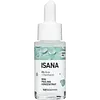What's inside
What's inside
 Key Ingredients
Key Ingredients

 Benefits
Benefits

 Concerns
Concerns

 Ingredients Side-by-side
Ingredients Side-by-side

Water
Skin ConditioningMandelic Acid
AntimicrobialGlycerin
HumectantShikimic Acid
Skin ConditioningPolyglycerin-6
HumectantSodium Hydroxide
BufferingAzelaic Acid
BufferingBetaine
HumectantGluconolactone
Skin ConditioningPentylene Glycol
Skin ConditioningFructose
HumectantUrea
BufferingCentella Asiatica Callus Conditioned Media
Skin ConditioningAllantoin
Skin ConditioningMaltose
MaskingTrehalose
HumectantGlucose
HumectantSodium Hyaluronate
HumectantSodium Lactate
BufferingSodium PCA
HumectantSodium Chloride
MaskingCalcium Gluconate
HumectantSodium Benzoate
MaskingCitric Acid
BufferingWater, Mandelic Acid, Glycerin, Shikimic Acid, Polyglycerin-6, Sodium Hydroxide, Azelaic Acid, Betaine, Gluconolactone, Pentylene Glycol, Fructose, Urea, Centella Asiatica Callus Conditioned Media, Allantoin, Maltose, Trehalose, Glucose, Sodium Hyaluronate, Sodium Lactate, Sodium PCA, Sodium Chloride, Calcium Gluconate, Sodium Benzoate, Citric Acid
 Reviews
Reviews

Ingredients Explained
These ingredients are found in both products.
Ingredients higher up in an ingredient list are typically present in a larger amount.
Citric Acid is an alpha hydroxy acid (AHA) naturally found in citrus fruits like oranges, lemons, and limes.
Like other AHAs, citric acid can exfoliate skin by breaking down the bonds that hold dead skin cells together. This helps reveal smoother and brighter skin underneath.
However, this exfoliating effect only happens at high concentrations (20%) which can be hard to find in cosmetic products.
Due to this, citric acid is usually included in small amounts as a pH adjuster. This helps keep products slightly more acidic and compatible with skin's natural pH.
In skincare formulas, citric acid can:
While it can provide some skin benefits, research shows lactic acid and glycolic acid are generally more effective and less irritating exfoliants.
Most citric acid used in skincare today is made by fermenting sugars (usually from molasses). This synthetic version is identical to the natural citrus form but easier to stabilize and use in formulations.
Read more about some other popular AHA's here:
Learn more about Citric AcidSodium Hydroxide is also known as lye or caustic soda. It is used to adjust the pH of products; many ingredients require a specific pH to be effective.
In small amounts, sodium hydroxide is considered safe to use. However, large amounts may cause chemical burns due to its high alkaline.
Your skin has a natural pH and acid mantle. This acid mantle helps prevent harmful bacteria from breaking through. The acid mantle also helps keep your skin hydrated.
"Alkaline" refers to a high pH level. A low pH level would be considered acidic.
Learn more about Sodium HydroxideWater. It's the most common cosmetic ingredient of all. You'll usually see it at the top of ingredient lists, meaning that it makes up the largest part of the product.
So why is it so popular? Water most often acts as a solvent - this means that it helps dissolve other ingredients into the formulation.
You'll also recognize water as that liquid we all need to stay alive. If you see this, drink a glass of water. Stay hydrated!
Learn more about Water